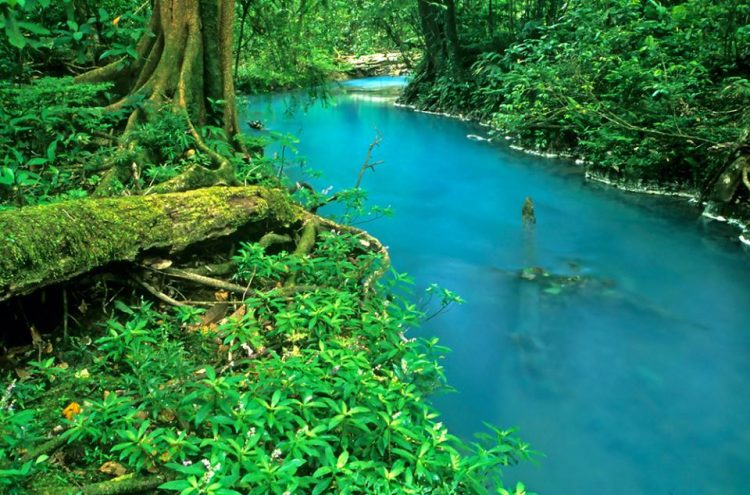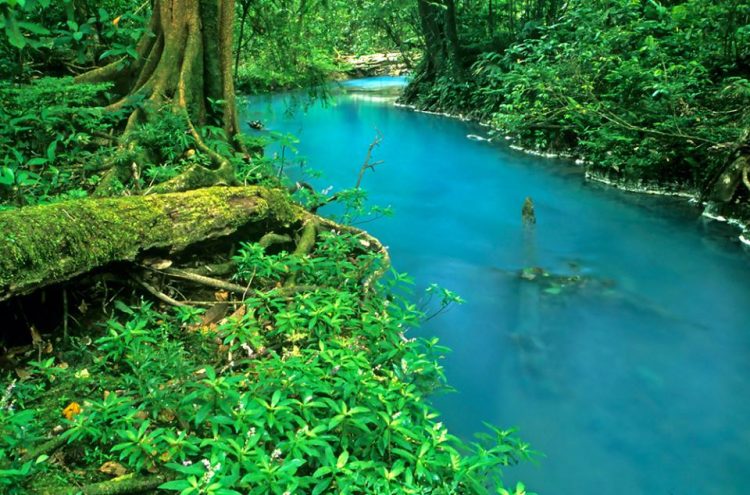Up until four years ago, Rio Celeste, a 14-kilometer river in Costa Rica’s Alajuela province, was a complete mystery to scientists, who could not understand why its waters had an unusual turquoise color. And then they realized that it wasn’t turquoise at all.
Theories regarding the turquoise color of Rio Celeste had been circulating in the scientific community for years, but nobody had ever managed to provide enough evidence to solve this natural enigma. Some claimed that the unusual coloring was caused by high levels of copper, but tests revealed that there was no copper in the water, others said that it was due to chemicals like calcium carbonate and sulfur, and some even connected it to the river’s proximity to the Tenorio Volcano. Everyone was so convinced that a mysterious chemical reaction was turning the water turquoise that they never even entertained the possibility of an optical illusion.

Photo: Rio Celeste/Facebook
Then, in 2013, a team of scientists from the Universidad the Costa Rica and the Universidad National, took water samples from both Rio Celeste, and its two tributaries, Sour Creek (Quebrada Agria) and the Good View River (Río Buena Vista). The first thing that caught the scientists’ attention was that while the waters of Rio Celeste were a vibrant turquoise, the samples they collected in their test tubes were completely transparent.

Photo: Rio Celeste/Facebook
To fully understand the mystery of Rio Celeste, it is important to know that Sour Creek and Río Buena Vista, the two rivers that converge to create this fascinating body of water, are both completely transparent, and analysis reveal no unsual chemical reactions. What’s even more interesting is that Rio Celeste is only turquoise for a 14-km stretch, after which its waters become transparent. For this reason, the unusually-colored section of the river is known as “The Dyer” (El Teñidero).

Photo: Rio Celeste/Facebook
As tests revealed no unusual chemicals in the water, and keeping in mind that the water only appeared turquoise in the river bed, Costa Rican scientists started considering the possibility of an optical illusion. They noticed a layer of a whitish substance that covered all the rocks at the bottom of the Río Celeste, and checked its two tributaries for it, as well. Sour Creek had very small, almost insignificant, quantities of it, but it was abundant in the water of Río Buena Vista.

Photo: Rio Celeste/Facebook
Analyzing the substance with electron microscopy in UCR laboratories, the scientists determined that it was a type of mineral composed of aluminum, silicon and oxygen, called aluminosilicate, that when suspended in the water reflected sunlight and tricked the human eye into seeing the water turquoise.

Photo: Rio Celeste/Facebook
“Sunlight contains the entire color spectrum, similar to the way we see them all in a rainbow. In any other river sunlight penetrates to a certain depth and no particular color is deflected or reflected back to the surface, so it looks transparent, while in the Río Celeste the water passes some of the Sun’s rays, but reflects the bluish tone group. So the water appears blue to the human eye,” The Costa Rica Star newspaper reported in 2013.

Photo: Rio Celeste/Facebook
There was only one puzzle left to solve, though. If Rio Buena Vista also had an abundance of aluminosilicate, how come its water looked completely transparent, while Rio Celeste appeared to be turquoise? It turned out to be a matter of particle size. Upon analyzing samples from both bodies of water, scientists realized that aluminosilicate particles in Rio Buena Vista measured 184 nanometers (nm), while those in Rio Celeste were much larger at 566 nm.
“This increase in size is what causes the scattering of sunlight, such that it occurs principally in the blue region of the visible spectrum. So that’s why we have that spectacular light blue color of the Rio Celeste” said Dr. Max Chavarría Vargas, who lead the scientific investigation into the turquoise waters of Rio Celeste. “It’s one of those quirks of nature where one of the rivers provides mineral material with one size and the other river provides the acidic environment so that those particles grow.”
Interestingly, the Rio Celeste phenomenon is unique in the world.













